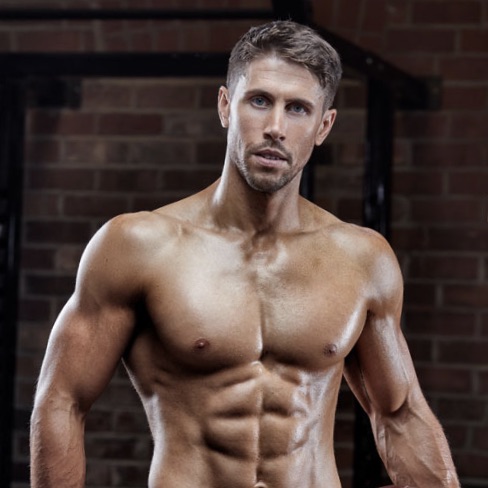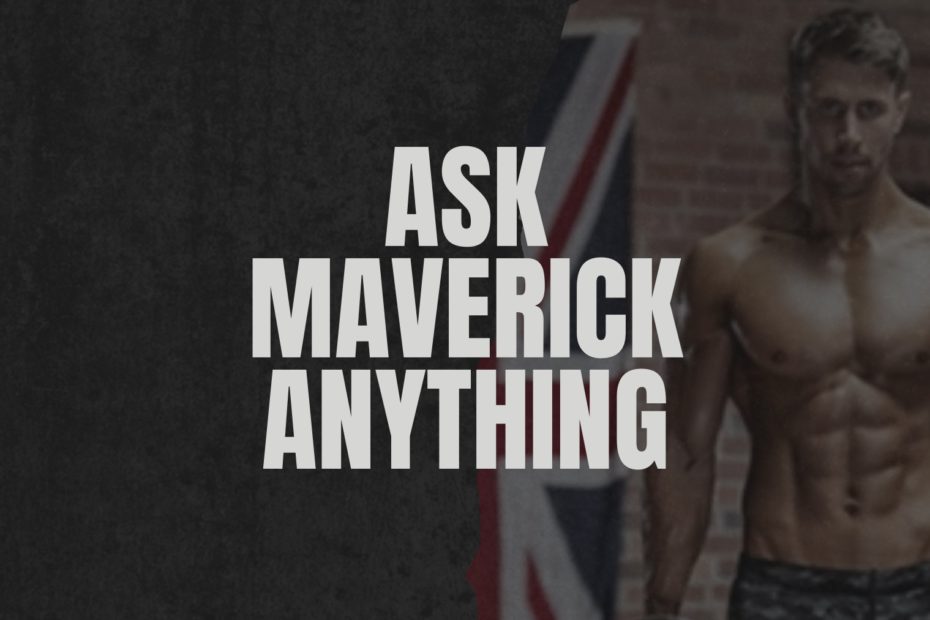In todays AMA I answer your questions on diet motivation, best exercises for a wider back, how long you should stick with an exercise for, and thoughts on foam rolling.
How many weeks do I need to stick to a plan for in order to build muscle?
For those changing-up their workouts every week I’ve got bad news for you. An exercise will only build muscle optimally if stuck to for AT LEAST 3-4 weeks OR 6 repeated “exposures”. That’s the minimum. What I mean by exposures are how many times you’ve used said exercise, regardless of how many weeks you’ve done it over. For example, if you’re using an exercise twice each week then you’ll have repeated it six times over the course of three weeks. But, if you’ve only used that exercise once per week then it would take you 6-weeks of using it to see most of the benefits.
Here’s another example: Let’s say I want to build my shoulders and have chosen a seated dumbbell shoulder press to be one of the main exercises to do that. After the first couple weeks of sticking with it you’re tending to build mostly what’s referred to as sarcoplasmic hypertrophy. It’s sometimes referred to as a “non-functional hypertrophy” since you’re not building the contractile proteins within muscle fibers, and instead increasing the fluid within the sarcoplasm, and increasing glycogen storage along with that. It’s only after a few weeks of using your dumbbell shoulder press that what’s referred to as myofibrillar hypertrophy truly starts taking place. This is when the contractile proteins within the muscle fiber increase in volume and density.
Even if you swapped, say, your seated dumbbell shoulder press for a seated barbell shoulder press (which is extremely similar), although there would be a large portion of exact muscle fibers that were used in both exercises and continued stimulation of them, there would also be a portion of them that would differ. Therefor switching exercises too early would not allow those differing fibers to see the full benefits and myofibrillar hypertrophy to take place. Obviously the closer the exercise the less of a problem this is, but when you’re trying to get the one-percenters then every little helps.
Swapping a dumbbell shoulder press for a barbell shoulder press after a week or two isn’t the worst thing, but I’d rather you spend at least 3-4 weeks with the dumbbells to make a real difference. If you’re swapping your seated dumbbell shoulder press for a landmine shoulder press after a week or two (which has even less in common) then you’re really short-changing your shoulders growth.
Caveat: You don’t necessarily have to do this with every exercise in your workout. More frequent rotation of your perceived “less important” exercises could actually be a good thing, especially for more muscle-building longevity. For example if your shoulders are a priority then stick with those dumbbell shoulder presses for at least 3-4 weeks, but the triceps pushdowns you might do towards then end of that workout could be changed every week.
I’ve struggled with diet motivation this week and have gotten off track a few times. Any suggestions?
Note: This question came from one of my online coaching clients, Carlos.
You’ve got to see dieting as compounding interest. Each week you earn “interest on interest” by making those small changes that eventually add up to one giant pay day! The more small changes to your diet that we accumulate over time, the more you’ll feel you can do and the easier dieting will become.
This is why rather than to set you an “ ideal” diet from day 1, it’s far better to look at your current diet and what you prefer to eat, then make small changes to that in order for it to fit in with our calorie and macronutrient goals.
This week hasn’t been “perfect” but compared to when we started it’s heaps better. So, rather than trying to be “perfect” next week — ultimately falling a little short and losing motivation — let’s look at this week and improve on that just a little. Let’s focus on when you were eating out because it’s on those days you struggled most with hitting your daily goals.
On Friday you ended up having fewer calories at breakfast and only a scoop of protein powder as a snack because you used up a disproportionate about of calories at Chick-fil-a at dinner. I’m not saying this coming week no Chick-fil-a or eating out, but instead of the spicy chicken sandwich with waffle fries you can swap these for better choices on the menu.
How about a grilled chicken sandwich instead of the spicy chicken one, and some grilled nuggets and dip on the side instead of fries? That’s far fewer calories, more protein, and fewer carbs and fats. You then have more room in your day for other things, gain a sense on “winning” by keeping your diet on track, and won’t feel like you’ve failed if you eat out.
There’s no need to be perfect 24/7, but as long as we’re changing some of these little habits then the accumulation of that interest over time will lead to a big change. Build on that great work you’re already doing.
What would be your top 3 exercises for a wider back?
Let’s just assume that after reading this you’re going to try all of these immediately!! For many, the following three exercises will work well and complement each other nicely within the same program (done on the same day or within the same phase of training):
1 – A pulldown or pull-up variation that emphasizes working your lats in more of their lengthened range. For this an underhand grip tends to work best as it feeds more external rotation at the shoulder joint as your arms go overhead (your lats function as internal rotators of your shoulder joints so going into a degree of external rotation will help lengthen them fully). For this purpose I like rack chin-ups (DC pull-ups), weighted chin-ups when performed correctly, pulldowns using an underhand grip, or if you have access to Hammer Strength equipment then 1-arm ISO pulldowns as shown here are also a good option.
2 – a pulldown or pull-up variation that works to load your lats in more their shortened range. Some of the above exercises can do this too, but if we’re going to work all these exercises in together then I’d tend to prefer adding in something using a neutral (or near-neutral) grip rather than another underhand variation. Since lats originate at the pelvis and sacrum you want to be thinking about pulling your elbow down tight into your sides (shoulder adduction) and into your pockets. You’ll notice that “tight” allow and the arm path in the ISO pulldowns above. Bench-supported pulldowns are a good option using a neutral grip.
3 – An exercise to target the more neglected thoracic region of your lats. While shoulder adduction exercises like the aforementioned do a great job at biasing more the middle and lower fibers of your lats (lumbar and pelvic regions), the upper fibers can benefit more from shoulder extension exercises such as rows. We want to be using row variations with your lats in mind. Here’s one of my favorites where the key here is the more arcing pattern of the row (with or without the band).
A note on pullovers and straight-arm pulldowns: I’m a big fan of them, especially as a way to further target your lats using that shoulder extension patterns and without fatiguing your grip. Depending on your setup you can also manipulate them to challenge you at different points of the exercise. For example emphasize the stretch, or making it more challenging at the mid-way point, and so-on. If I had a fourth exercise to pick it would be a pulldown or pullover variation. Try straight-arm pulldowns performed using partial repetitions in the top-half of the movement. Bend forward a little and keep a slight bend in your elbows throughout, almost pulling down like a “J” (down and in).
Thoughts on foam rolling? Should it hurt?
Foam rolling and other soft tissue work does have a place in my opinion, but not when it involves mindless painful humping, which is how most tend to approach it. Additionally, if you feel you need to foam roll for 10-20 minutes at the start of every workout just to feel ‘okay’ in your main lifts, then it’s the main lifts that need rethinking. While some people feel better foam rolling at the start of their workouts (and that’s fine if feel-good factor is the aim), any benefits physiological/mechanical are temporary and can work agains you in the long run. Instead, I’d recommend if wanted to use it then do so at the end of your workouts, or in separate active recovery-based workouts.
Any positive effects associated with foam rolling are mostly related to the stimulation of certain receptors within muscle and/or fascia. Because of how these receptors work then foam rolling should not hurt. Mild discomfort, maybe. But not common assault by foam roller. The “no pain, no gain” approach will over-simulate your nervous system leaving you even tighter in the long run and relying on repeated humping of your foam roller before every workout just to see some temporary benefits.
If you have questions about anything covered in todays article or for future articles then please send them to me directly through Instagram, Facebook or using the comments box below. For more specific help you can check out my online coaching program HERE.

I build Olympians, Cover Models and those who want to look like them. Author or “Ultimate Abs” available in all good book stores.
